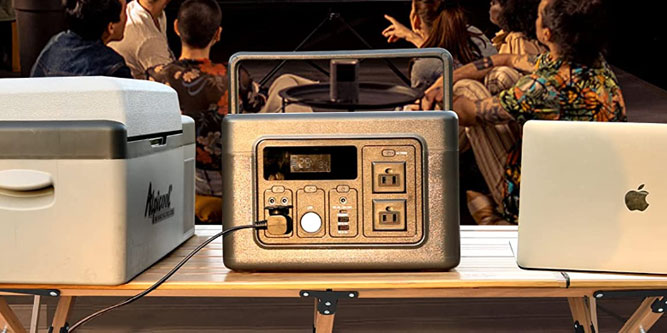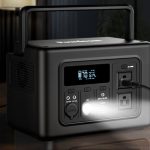Powdeom EN700
Pros
- Compact and portable design.
- Very powerful for the size.
- Can simultaneously charge or power 8 devices.
- Re-charges in less than 90 minutes.
- Built-in handle is great for moving around.
Cons
- Flashlight is located on the front.
- AC outlets don’t support pass-through charging.
- Screen is a bit small.
Having a supply of backup power isn’t optional. It used to be that you could get through an afternoon without electricity. But these days, pretty much everything requires power. When it goes out, your smartphone, laptop, and tablet are all on life support. A good power supply will keep you charged until the power comes back on. That way, you can work, entertain yourself, and stay in touch with friends and family.
A portable power supply can also be useful whenever you’re out of the house. Let’s say you’re going camping for the weekend. You probably want to charge your phone or camera, or maybe you want to run a small electric kettle. In that kind of situation, you’re going to need a power station. They can even come in handy for backyard parties as an alternative to running extension cords across your lawn.
Today, we’re going to review the Powdeom EN700 Portable Power Station. This is a compact power station that’s designed to be easy to travel with. It can charge up to eight devices simultaneously, and will charge from wall power in under 90 minutes. But those are just a couple of the features we’ll need to think about. We’ll take a deep dive into all of its functions, and deliver a final verdict. Let’s begin!
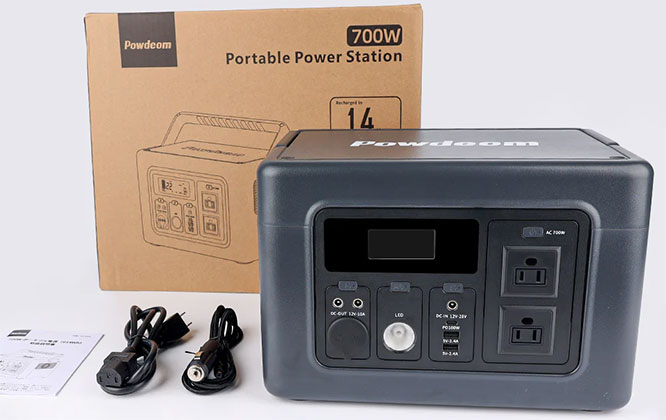
Design and Durability
The Powdeom Portable Power Station has a blocky rectangular housing with a matte black finish. It’s compact, at 12 inches wide, 8.27 inches deep, and 7.87 inches tall. At 17.85 pounds, it’s heavy for the size, but still on the light side as power banks go. It’s also very easy to carry. A black plastic handle is built into the top, and flips up and down when needed.
On top of the housing is a white “Powdeom” imprint, but there’s otherwise virtually zero branding. On the bottom is a set of little rubber feet. These keep the power station from sliding around if you don’t want it to. They also protect any delicate surfaces you might set it on. You can put it on a wood table and not have to worry about damaging it.
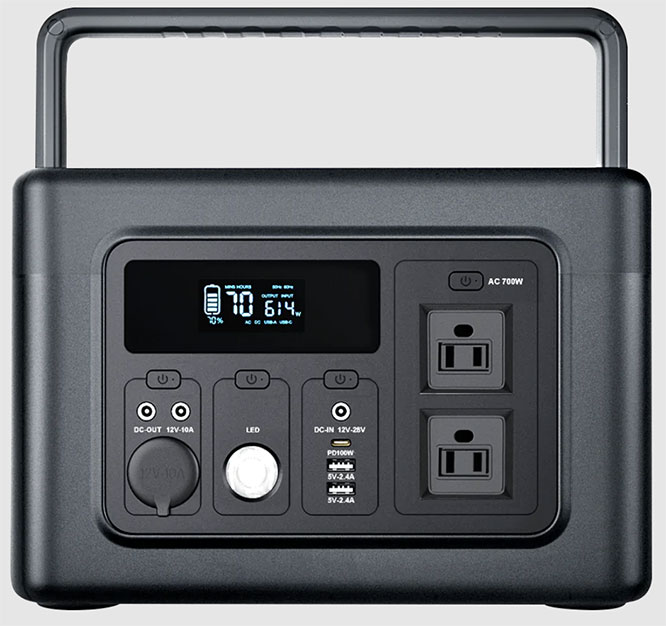
The charging ports are arrayed across the front of the housing, along with an LCD display. The sides, meanwhile, have vents across the tops, with fans built into the centers. These fans draw air through the inside of the unit, which prevents it from overheating. Some power stations’ fans can get pretty loud when they’re at full power, but that’s not a problem here. These fans are extremely quiet, and you’ll barely notice them.
Powdeom backs their power station with a 36-month manufacturer’s warranty. If you encounter any defects in materials or workmanship, you’ll receive a refund or a free replacement.
Ports and Display
As we mentioned, the power ports and display are on the front of the power station. The blue-on-black LCD screen is located at the top left. This display shows a variety of information about the system’s status. To begin with, there’s a battery meter, which shows both a visual bar graph and a percentage. In large numerals, you’ll see your estimated remaining operating time. In smaller numbers, you’ll see your incoming and outgoing wattage. There are also tiny indicators along the bottom of the display that show what ports are currently in use.
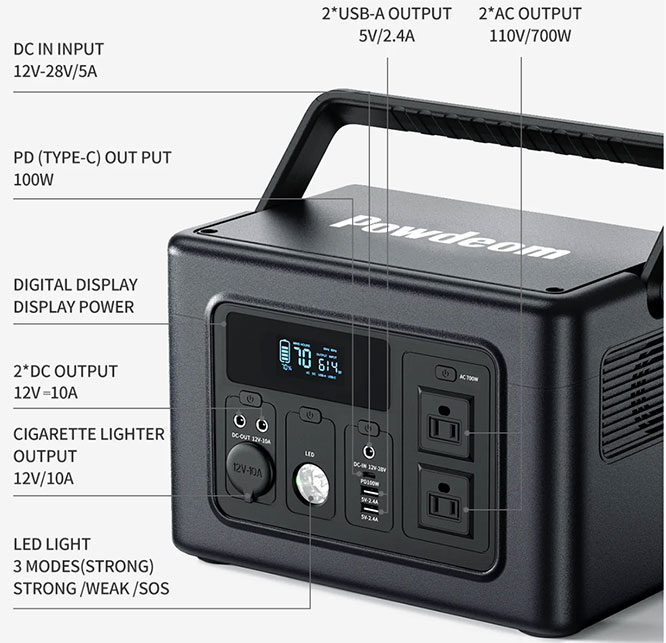
Underneath the display, at the bottom left, is a circular DC automotive charging port. This port has a black plastic cover that’s hinged at the bottom. The cover keeps debris from getting into the socket when it’s not in use. Above the automotive port is a pair of circular DC ports that accept barrel-style plugs. This cluster of three sockets is controlled by a button that’s positioned just above them. By shutting off inactive power ports, you’ll prevent them from wasting any current.
Next in line is a flashlight with its own controller button. The light works well as far as it goes, and is fairly bright. That would normally be a good thing, but the positioning is all wrong. Because the light is on the front of the unit, it makes it impossible to see the display while it’s lit. It would have been better on the side or the back.
After the flashlight, you’ll find three more ports. There’s a pair of USB Type-A ports on the bottom, with a USB Type-C port just above it. A separate control button operates this group of ports.
At the far right, you’ll find a pair of 3-prong AC outlets, stacked one over the other. As with the other types of outlets, they function as a group, and are controlled by a black button just above them.
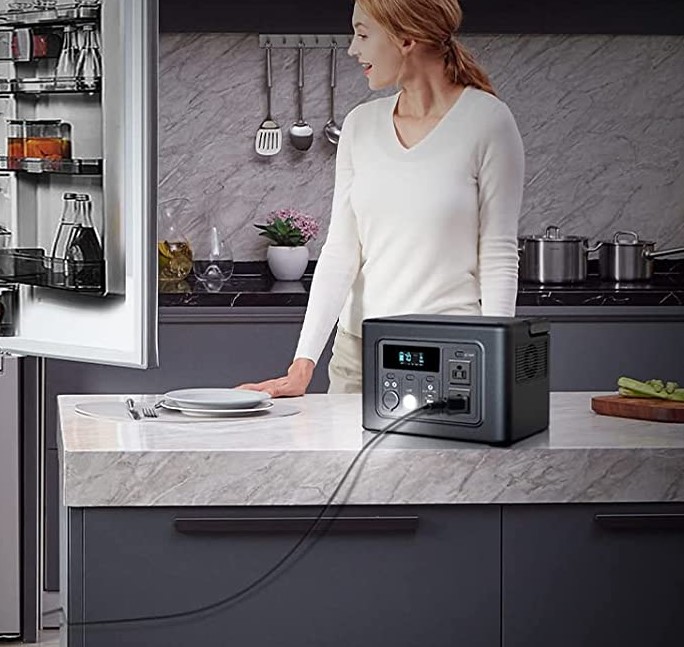
Battery Capacity and Recharging
The Powdeom Portable Power Station has an impressive capacity for the size. The internal battery can hold up to 614Wh, or 192,000mAh. That’s enough to charge an iPhone 14 Pro Max more than 30 times. You could also charge a MacBook Pro 16” six times, with a little bit of juice left over. You’re not about to operate any major appliances. But for charging everyday devices and running lower-powered machines, you’ll have plenty of power.
Even with this relatively large capacity, you’re looking at a very short charging time. The AC input can draw as much as 500 watts from your wall outlet. This allows you to charge the battery to 80% in under an hour. And in less than half an hour, you’ll have a 100% charge. Using a solar power, you can charge at up to 120 watts. Assuming maximum efficiency, you could fully charge the battery in a little over six hours. Or you can use the DC automotive charger and charge while you’re driving.
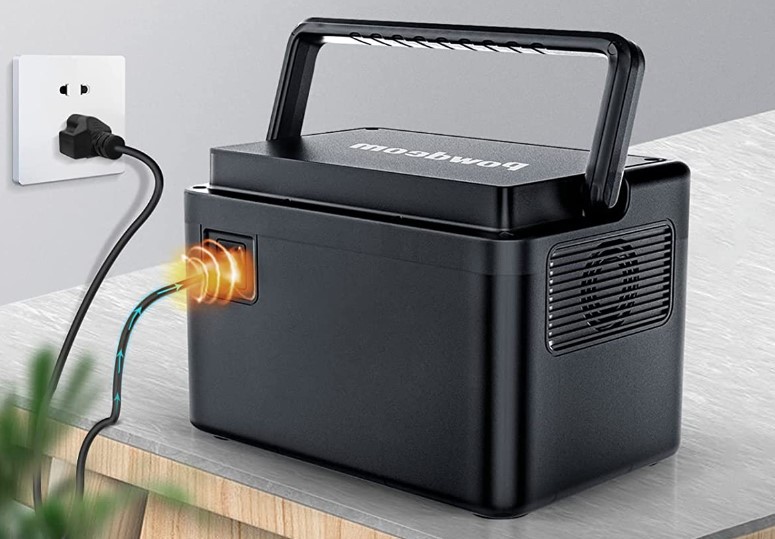
The AC charging input is located on the back side of the housing. The DC charger uses a barrel-shaped adapter, which plugs into a socket on the front, just above the USB ports. Both an AC and a DC charger are included in the package, so you don’t have to buy anything extra.
The LiFePO4 (Lithium-iron phosphate) is rated for 3,000 duty cycles. That means it can drain and charge 3,000 times and still retain 80% of its original capacity. This is a truly insane level of durability, and allows for years of heavy use.
Charging & Power Capabilities
We’ve talked about the battery capacity. But how fast are you able to access that power? As with any power station, it’s going to depend on which port you’re plugged into.
Let’s start with the AC power outlets. These are capable of providing up to 700 watts of power. By comparison, a typical wall outlet provides up to 1,800 watts. Most small microwaves will draw around 700. Anything you’re trying to charge, like a laptop, won’t even come close to 700 watts. You can also get up to 1,400 watts of surge power. The battery can sustain this for a brief period, such as when a compressor-driven device spools up. Keep in mind that 700 watts is the total for the entire power station. If you’re drawing 700 watts from one AC outlet, you won’t be able to do anything else.
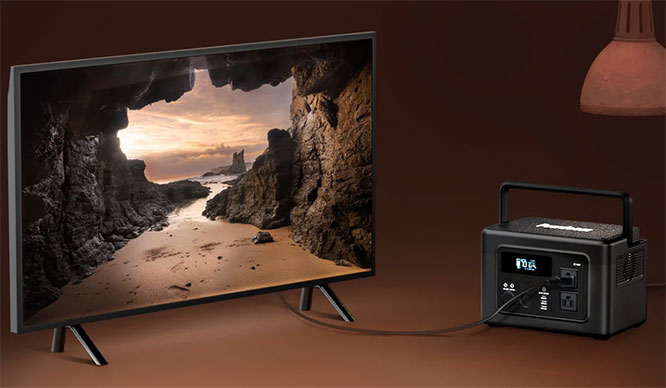
The USB Type-A ports can output up to 12 watts. That’s the standard for USB power. And while it’s not all that impressive, it will charge your smartphone or other USB device just fine.
If you want a little more oomph, the USB Type-C port can supply up to 100 watts. That’s the maximum for USB Type-C, and it can charge even high-powered devices. You’ll be able to charge your USB Type-C laptop and use it at the same time. That’s simply not the case for an ordinary Type-C port.
Pass-through charging is a bit messy. It works for USB Type-A, but not for any of the other ports. This means you can charge your USB devices while the power station is charging. But if you try to use anything else, you won’t have a power supply.
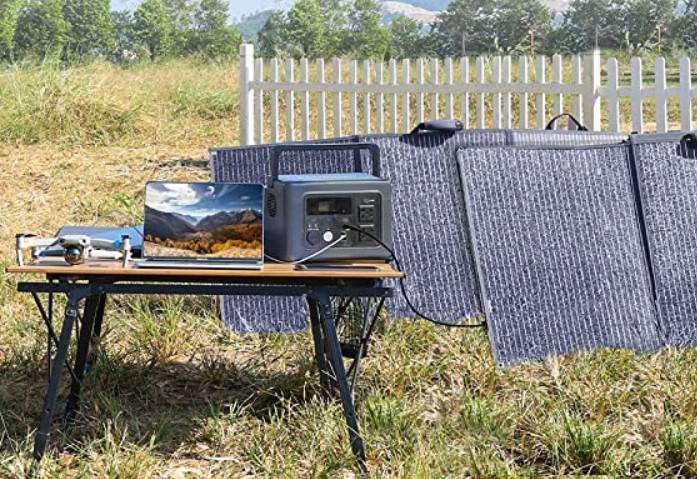
Safety and Extras
The Powerdom power station delivers pure sine wave AC power. When most inverters output AC power, the waveform is jagged. This can cause damage to some analog devices, or cause them to malfunction. Pure sine wave power is smoothed out so the waveform will won’t damage your electronics. As a result, you can use it for something like a CPAP machine, which won’t work with typical inverters.
A built-in battery management system (BMS) provides a handful of important protections. It ensures that the system shuts down if the voltage exceeds the maximum. It also keeps the internal battery from overcharging, so you won’t inadvertently damage it.
We should also point out that the flashlight has three distinct modes. In ordinary mode, it’s very bright, and provides enough light to cover a wide area. In low light mode, the lantern is dimmed, and it’s more suitable for a small space like a tent. The SOS mode flashes very brightly so you can signal for help in an emergency.
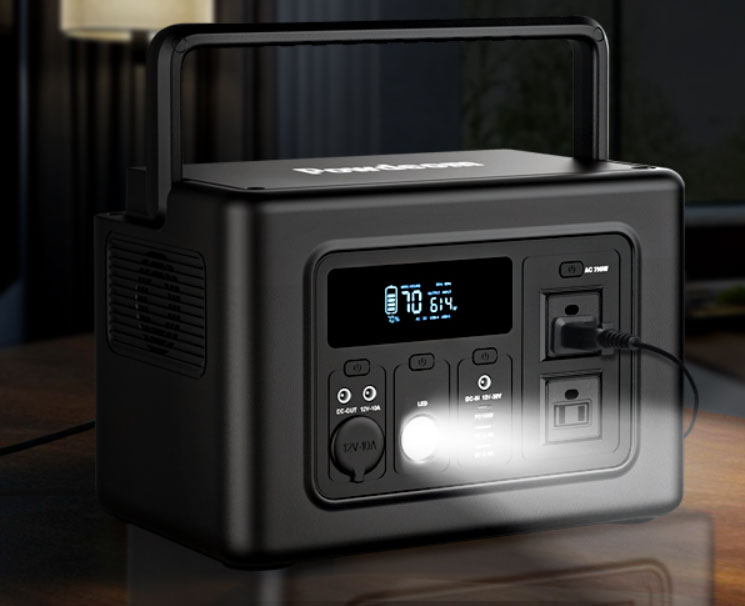
Final Verdict
The Powdeom EN700 Portable Power Station is a well-designed power station in many respects. To begin with, we liked the compact design and fold-down handle. Despite weighing a little over 17 pounds, it’s fairly easy to carry around. The quiet fans are also a plus, especially if you’re trying to get some sleep.
Not everything is perfect. While the flashlight works well and has three modes, it should be on the back or one of the sides. We also would have liked to see pass-through charging for the AC outlets. It would be a great thing for CPAP users, and for many other applications
That said, you’re looking at a capable little machine. It has a surprising amount of capacity for the size, with up to 700 watts of power delivery. It’s also very safe, with a BMS that provides several protections. All things consider, this is one of the more impressive small power banks on the market.
Meet Ry, “TechGuru,” a 36-year-old technology enthusiast with a deep passion for tech innovations. With extensive experience, he specializes in gaming hardware and software, and has expertise in gadgets, custom PCs, and audio.
Besides writing about tech and reviewing new products, he enjoys traveling, hiking, and photography. Committed to keeping up with the latest industry trends, he aims to guide readers in making informed tech decisions.

